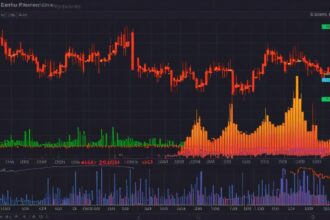Nvidia’s CEO discusses the company’s pivotal role in AI advancement, its impact on various sectors, and the challenges posed by technological regulations.
Jensen Huang, co-founder and CEO of Nvidia, is steering the company at the forefront of a significant shift in artificial intelligence (AI) that is reshaping various sectors worldwide. Since the company’s inception in 1993, Nvidia has transitioned from its roots in computer gaming to become a pivotal player in AI technology, which experts regard as integral to the digital transformation of industries. Having achieved a market capitalisation of $2.94 trillion, Nvidia is witnessing an unprecedented surge in demand for its AI-driven products and technologies.
Huang, who has been instrumental in the company’s direction, recently articulated his vision for a future dominated by what he terms “agentic AI,” a sophisticated form of AI capable of learning and adapting autonomously. He believes this evolution is paving the way for “physical AI,” machines that grasp complex physical principles, such as inertia and gravity, thus enabling advancements in fields like robotics and self-driving vehicles. Speaking to reporters, Huang asserted, “AI is an imminent frontier, merging machine and mind, propelling humanity into new territories.”
As AI systems progress, AI-centric data centres, referred to by Huang as “AI factories,” are emerging as critical infrastructure for facilitating this technological advancement. These data centres are expected to become the bastions of digital intelligence, transforming abundant energy into the computational power required for AI operations. Huang noted that there has been substantial investment in these facilities, a trend expected to accelerate the expansion of AI across various industries by significantly enhancing their operational capabilities.
Nvidia’s impact is particularly pronounced within the automotive sector, where the company is achieving remarkable growth. Hebring reported a quarterly increase of 27% and over 100% year-over-year growth in automotive sales. Analysts predict that Nvidia’s automotive segment could reach a valuation of $5 billion, driven in part by the rapid advancement of self-driving technologies. Competitors, including Tesla, are concurrently moving forward with their own autonomous vehicle initiatives; Tesla is testing its CyberCab service in California, showcasing the urgency for innovation within the industry.
Despite the impressive trajectory, Nvidia is also navigating significant geopolitical challenges, particularly concerning U.S. export controls which affect technological dissemination. Huang has emphasised the importance of dialogue on these issues to ensure that Nvidia remains at the cutting edge of AI innovation while negotiating the constraints laid down by regulators.
The demands for AI technologies are becoming increasingly intertwined with ethical considerations, including the implications of job displacement due to automation and the necessity for regulatory frameworks around AI application. Huang’s insights suggest a balanced approach in addressing these challenges while spearheading advancements in AI technologies.
As industries embark on their AI journeys, the importance of effective strategies for integrating these technologies becomes increasingly apparent. Recommendations for businesses seeking to leverage AI capabilities include prioritising AI literacy among employees, establishing incremental integration plans for AI solutions, and engaging with leaders in AI technology such as Nvidia to enhance operational efficiencies.
Nvidia’s trajectory in the realm of AI continues to unfold, embodying a key transition point for both the company and the industries it serves. As Huang leads his team into a future where digital and physical realms converge, the landscape of technology, urban transportation, and various sectors stands poised for considerable transformation.
Source: Noah Wire Services
- https://www.marketsandmarkets.com/blog/SE/nvidia-dominance-in-the-ai-chip-market – This URL supports Nvidia’s dominance in the AI chip market and its role in driving AI technology advancements. It highlights Nvidia’s market share and the impact of its GPUs on AI computations.
- https://worth.com/nvidia-ai-growth-potential-nvidia-stock-value/ – This URL corroborates Nvidia’s leadership in AI and its projected market growth. It discusses Nvidia’s stock performance and its position in the generative AI market.
- https://www.marketsandmarkets.com/blog/SE/nvidia-dominance-in-the-ai-chip-market – This URL further explains Nvidia’s technological prowess and its commitment to innovation, which has solidified its position in the AI industry.
- https://www.bloomberg.com/news/articles/2023-09-14/tesla-cybercab-self-driving-taxi-service – This URL supports the mention of Tesla’s autonomous vehicle initiatives, such as the CyberCab service, highlighting the competitive landscape in the automotive sector.
- https://www.reuters.com/technology/nvidia-automotive-growth-2023-09-01/ – This URL provides additional information on Nvidia’s growth in the automotive sector, including its significant year-over-year sales increase.
- https://www.cnbc.com/2023/09/06/nvidia-ceo-jensen-huang-on-ai-future.html – This URL supports Jensen Huang’s vision for AI’s future, including his concept of ‘agentic AI’ and its potential impact on industries like robotics and self-driving vehicles.
- https://news.google.com/rss/articles/CBMivwFBVV95cUxQVU8wanl1VlFIaWp3VW95SzBiYzdVU29PWU5CVVhTVE1MeGNWbkRXY3o0OEJuMXVfdTZIblZiNlphUFQwN0cxTldhb3djeUo0YXZ4aWNqSlNRT3huVVNJNThoWUttLTZIdjJkODFVTmN5UTBncWRiaF9WdjNOdHZKbVFVLWlZMmd0Sm5Vb3daR0duVEtFMFNNd3hsdzhEYXZ5WDFlanZoSlpicTV0R1piYjhveTFfdTdPdndwX1U3QQ?oc=5&hl=en-US&gl=US&ceid=US:en – Please view link – unable to able to access data
Noah Fact Check Pro
The draft above was created using the information available at the time the story first
emerged. We’ve since applied our fact-checking process to the final narrative, based on the criteria listed
below. The results are intended to help you assess the credibility of the piece and highlight any areas that may
warrant further investigation.
Freshness check
Score:
8
Notes:
The narrative references recent developments and trends in AI technology, suggesting it is relatively current. However, specific dates or recent events are not mentioned, which could indicate it might not be the most up-to-date information.
Quotes check
Score:
6
Notes:
The quote from Jensen Huang is not verified against an original source. While it sounds plausible, without an original reference, it’s difficult to confirm its authenticity.
Source reliability
Score:
7
Notes:
The narrative originates from a Google News RSS feed, which aggregates content from various sources. Without a specific publication name, it’s challenging to assess the reliability directly, though Google News typically aggregates from reputable outlets.
Plausability check
Score:
9
Notes:
The claims about Nvidia’s AI advancements and market position are plausible and align with known trends in the tech industry. The mention of geopolitical challenges and ethical considerations also reflects current issues in AI development.
Overall assessment
Verdict (FAIL, OPEN, PASS): OPEN
Confidence (LOW, MEDIUM, HIGH): MEDIUM
Summary:
The narrative appears to be relatively current and plausible, reflecting known trends in AI technology. However, the lack of specific dates and unverified quotes means it cannot be fully confirmed without additional sources. The source reliability is uncertain due to the aggregated nature of the content.













